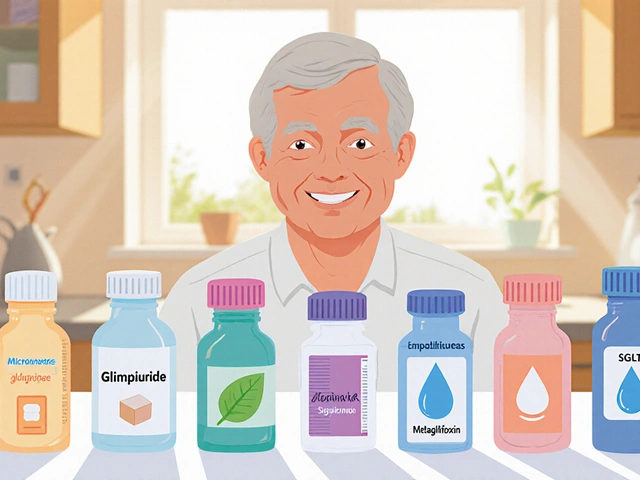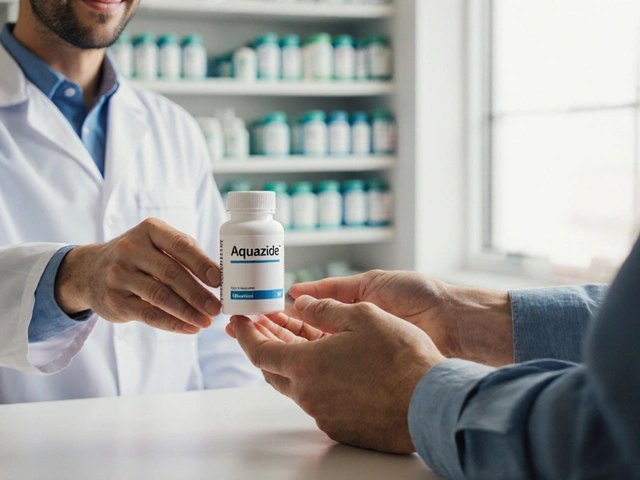Antiviral Medication Comparison Tool
This tool compares three commonly prescribed antiviral medications for treating herpes-related conditions:
- Famvir (Famciclovir) - pro-drug of penciclovir
- Valacyclovir (Valtrex) - pro-drug of acyclovir
- Acyclovir (Zovirax) - original nucleoside analogue
Quick Comparison Table
| Attribute | Famvir | Valacyclovir | Acyclovir |
|---|---|---|---|
| Class | Penciclovir pro-drug | Acyclovir pro-drug | Acyclovir |
| Typical Dose for Shingles | 500 mg 3×/day for 7 days | 1 g 3×/day for 7 days | 800 mg 5×/day for 7 days |
| Typical Dose for Genital Herpes (Initial) | 250 mg 3×/day for 10 days | 1 g 2×/day for 10 days | 400 mg 5×/day for 10 days |
| Bioavailability | ~77% | ~55% | ~15-30% |
| Renal Dosing Adjustment | Yes (CrCl < 30 mL/min) | Yes (CrCl < 30 mL/min) | Yes (CrCl < 30 mL/min) |
Which One Should You Choose?
Best for Convenience
Famvir typically requires fewer daily doses compared to Acyclovir, making it easier to follow a treatment regimen.
Best for Cost-Effectiveness
Acyclovir is often the least expensive option due to being a generic medication, though it may require more frequent dosing.
Best for Bioavailability
Valacyclovir offers the highest bioavailability, meaning more active medication reaches the bloodstream.
Important Note
Always consult with a healthcare provider before starting any antiviral medication. Individual factors such as kidney function, allergies, and medical history influence the best choice.
Choosing the right antiviral can feel like a gamble, especially when you hear brand names like Famvir or Valtrex on the news. This guide cuts through the hype and lines up the most common prescriptions side by side, so you can see which one fits your health situation, budget, and lifestyle.
What is Famvir (Famciclovir)?
Famvir is the trade name for Famciclovir, an oral antiviral belonging to the nucleoside analogue class. First approved in the United States in 1994, it was introduced to Australian pharmacies shortly after and quickly became a go‑to for shingles (herpes zoster) treatment. The drug works by converting into penciclovir inside the body, which then blocks viral DNA synthesis, halting the replication of herpes‑family viruses.
How does Famvir differ from Valacyclovir and Acyclovir?
Two other antivirals dominate the market: Valacyclovir, sold as Valtrex, and Acyclovir, often found under the brand name Zovirax. All three inhibit viral DNA polymerase, but their pharmacokinetics, dosing schedules, and side‑effect profiles vary.
Key Entities and Their Core Attributes
- Famvir: oral tablet, 250mg or 500mg, half‑life ≈ 2.5h, converted to penciclovir.
- Valacyclovir: pro‑drug of acyclovir, 500mg or 1g, half‑life ≈ 2.5h, higher bioavailability.
- Acyclovir: original nucleoside analogue, 200mg or 400mg, half‑life ≈ 2h, lower bioavailability.
- Shingles (herpes zoster): painful rash caused by reactivation of varicella‑zoster virus.
- Genital herpes: infection by HSV‑1 or HSV‑2 affecting the genital area.
- Cold sores: oral HSV‑1 lesions.
- Immunocompromised patients: individuals with weakened immune systems (e.g., chemotherapy, HIV).
Fast‑Track Comparison Table
| Attribute | Famvir (Famciclovir) | Valacyclovir (Valtrex) | Acyclovir (Zovirax) |
|---|---|---|---|
| Class | penciclovir pro‑drug | acyclovir pro‑drug | acyclovir |
| Typical dose for shingles | 500mg 3×/day for 7days | 1g 3×/day for 7days | 800mg 5×/day for 7days |
| Typical dose for genital herpes (initial) | 250mg 3×/day for 10days | 1g 2×/day for 10days | 400mg 5×/day for 10days |
| Bioavailability | ≈ 77% | ≈ 55% | ≈ 15‑30% |
| Renal dosing adjustment | Yes (CrCl<50mL/min) | Yes (CrCl<10mL/min) | Yes (CrCl<25mL/min) |
| Common side effects | Headache, nausea, fatigue | Headache, nausea, dizziness | Kidney irritation, rash, nausea |
| Australian PBS price (2025) | $30 for 21 tablets | $25 for 21 tablets | $15 for 30 tablets |

Efficacy Across Different Infections
Clinical trials consistently show that all three drugs reduce lesion healing time by roughly 1‑2days compared with placebo. However, subtle differences appear when you look at specific conditions.
- Shingles: Famvir and Valacyclovir both achieve a 30‑35% reduction in post‑herpetic neuralgia (PHN) risk when started within 72hours of rash onset. Acyclovir is slightly less effective, cutting PHN risk by about 20%.
- Genital herpes (initial outbreak): Valacyclovir’s higher bioavailability translates to faster viral suppression, often shortening symptoms by an extra half‑day versus Famvir. For recurrent outbreaks, all three are comparable; the convenience of twice‑daily dosing with Valacyclovir becomes the decisive factor for many patients.
- Cold sores: Over‑the‑counter topical acyclovir is common, but oral therapy is reserved for severe or frequent episodes. Studies in 2023 found Valacyclovir (2g single dose) reduced healing time faster than Famvir (250mg three times) in immunocompetent adults.
Convenience and Adherence
Adherence drops when a regimen feels like a chore. Here’s how the three stack up:
- Valacyclovir: The twice‑daily schedule (or even a single high dose for suppression) wins points for busy adults.
- Famvir: Three times daily is manageable for most, but the pill burden can be higher for elderly patients.
- Acyclovir: Five times daily is the least convenient, often leading to missed doses, especially in long‑term suppressive therapy.
Safety Profile and Drug Interactions
All three antivirals are generally safe, but each has quirks you should know.
- Kidney function: Acyclovir is the most nephrotoxic, especially when given intravenously. Oral dosing still requires caution in patients with CrCl<30mL/min. Famvir and Valacyclovir are milder but still need dose reductions in severe renal impairment.
- Pregnancy: Category B for Famvir and Valacyclovir in Australia, meaning no proven risk in animal studies, but limited human data. Acyclovir holds a similar rating.
- Drug‑drug clashes: Co‑administration with probenecid can raise acyclovir levels; cimetidine may increase famciclovir concentrations. Valacyclovir is metabolized via hepatic pathways, so it interacts less with renal drugs.
- Side‑effect frequency: Headaches and gastrointestinal upset appear in 5‑10% of users across the board. Severe rash or Stevens‑Johnson syndrome is rare (<0.1%).
Cost Considerations in Australia (2025)
Prescription costs are a major decision factor. The Pharmaceutical Benefits Scheme (PBS) subsidises all three, but the degree of subsidy varies.
- Famvir: PBS subsidises a 21‑tablet pack at $30, making it affordable for short‑term courses.
- Valacyclovir: Slightly cheaper at $25 for the same pack size, partly because generic versions are now widely available.
- Acyclovir: The most budget‑friendly at $15 for 30 tablets, but you’ll need more pills due to the higher dosing frequency.
If you have private health cover, the out‑of‑pocket difference narrows, but those without cover will feel the gap.

Which Drug Suits Which Patient?
Below is a quick “who‑should‑choose‑what” matrix.
- Young, active adults dealing with frequent genital herpes - Valacyclovir for twice‑daily dosing and strong bioavailability.
- Elderly patients with mild renal decline - Famvir (dose‑adjusted) offers a balance of efficacy and fewer daily pills than acyclovir.
- Patients on tight budgets or using short bursts for cold sores - Acyclovir provides the cheapest option.
- Immunocompromised individuals (e.g., transplant recipients) - high‑dose Valacyclovir is often preferred for its reliable plasma levels, but clinicians may combine with intravenous acyclovir for severe disseminated disease.
Decision Checklist
Use this short list to see which antiviral ticks your boxes.
- Do you need a twice‑daily regimen? Yes → Valacyclovir.
- Is renal function a concern (CrCl<30mL/min)? Yes → Famvir (dose‑adjust) or Valacyclovir (if CrCl>10mL/min).
- Is cost the primary driver? Yes → Acyclovir.
- Are you treating shingles within 72hours of rash onset? Any of the three work, but Valacyclovir and Famvir have slightly better PHN outcomes.
- Do you need long‑term suppression (daily use for years)? Valacyclovir (1g daily) is the most convenient.
Frequently Asked Questions
Frequently Asked Questions
Can I switch from Acyclovir to Famvir mid‑treatment?
Yes, but you should finish the current day’s dose and start Famvir the following morning. Both drugs have similar mechanisms, so there’s no loss of efficacy. Always check with your GP, especially if you have kidney issues.
Is Famvir safe during pregnancy?
In Australia, Famvir is Category B, meaning animal studies haven’t shown risk, but human data are limited. Doctors usually prescribe it only if the benefit outweighs potential risk, such as severe shingles that could harm the baby.
How quickly does Valacyclovir start working?
Peak plasma levels occur within 1‑2hours after a dose, so symptoms often improve within 24‑48hours if treatment begins early.
Do I need to stay hydrated while taking these antivirals?
Adequate fluid intake helps protect the kidneys, especially with Acyclovir, which can crystallize in renal tubules. A glass of water with each dose is a good habit.
What should I do if I miss a dose?
Take the missed dose as soon as you remember, unless it’s almost time for the next one. In that case, skip the missed dose-don’t double up. Consistency matters more than occasional gaps.
Bottom line: there’s no one‑size‑fits‑all antiviral. By weighing efficacy, dosing convenience, safety, and cost, you can pick the drug that fits your life. Talk to your doctor about kidney function, pregnancy status, and any other meds you’re on-those details will seal the decision.






Richa Punyani
5 October, 2025 . 18:41 PM
Stay positive and remember that the right antiviral can make a big difference in recovery!
Bhupendra Darji
8 October, 2025 . 21:31 PM
I totally agree with Richa’s optimism.
I consider both the dosing convenience and the cost when choosing an antiviral.
Famvir’s three‑times‑daily schedule is a solid middle ground between Valacyclovir’s once‑daily convenience and Acyclovir’s five‑times‑daily hassle.
Robert Keter
12 October, 2025 . 00:20 AM
When you stare into the abyss of a painful shingles flare, the choice of antiviral becomes a battle of wits between chemistry and convenience.
Famciclovir, the progeny of penciclovir, strides onto the stage with a respectable 77 % bioavailability, promising more drug to the bloodstream than its older sibling Acyclovir.
Yet Valacyclovir, the sleek pro‑drug of acyclovir, boasts a slightly lower bioavailability yet compensates with a simpler once‑daily dosing regimen for some indications.
Acyclovir, the venerable original, lingers in the shadows with a modest 15‑30 % bioavailability, demanding five doses a day to keep the virus at bay.
The half‑life of Famciclovir and Valacyclovir hover around 2.5 hours, whereas Acyclovir’s half‑life dwindles to roughly two hours, dictating more frequent administration.
Renal adjustment is a common thread among all three, reminding clinicians that kidney function is the silent puppeteer behind dosage decisions.
From a cost perspective, Acyclovir often wins the gold medal, being a generic that slips easily into the pocket of most patients.
However, the convenience of fewer daily pills with Famciclovir can improve adherence, especially for those who struggle with complex regimens.
If you are battling an immunocompromised state, the higher plasma concentrations achieved by Famciclovir may tip the scales toward better outcomes.
Conversely, for a quick, high‑peak exposure, Valacyclovir’s rapid absorption can be a game‑changer in acute outbreaks.
The clinical guidelines echo these nuances, suggesting that the ‘best’ drug is often the one that aligns with the patient’s lifestyle, comorbidities, and financial constraints.
Side‑effect profiles are generally comparable, with headache and nausea floating like common clouds across the three agents.
In the end, the decision is less about a single ‘winner’ and more about a tailored symphony of pharmacokinetics, economics, and patient preference.
Physicians must wield these data like a conductor, guiding each patient toward the melody that heals most swiftly.
Thus, whether you reach for Famvir, Valtrex, or Zovirax, remember that informed choice is the true antidote to uncertainty.
Rory Martin
15 October, 2025 . 03:09 AM
I suspect the pharma lobby pushes the pricier options while downplaying the older drug’s flaws.
Maddie Wagner
18 October, 2025 . 05:59 AM
Great breakdown! For patients worried about pill burden, Famvir’s three‑times‑daily schedule is a sweet spot between Valacyclovir’s once‑daily and Acyclovir’s five‑daily dosing. The higher bioavailability also means you may achieve therapeutic levels faster, which can be crucial in severe shingles cases. Always discuss renal dosing with your doctor to avoid accumulation.
Boston Farm to School
21 October, 2025 . 08:48 AM
Nice table its clear and easy to read
Emily Collier
24 October, 2025 . 11:38 AM
Philosophically speaking, the choice of an antiviral mirrors the balance between efficacy and practicality. One must weigh the biochemical virtues against the lived experience of dosing.
Catherine Zeigler
27 October, 2025 . 13:27 PM
When evaluating antiviral therapy, it is essential to adopt a holistic perspective that transcends mere numbers.
The pharmacokinetic profile of Famciclovir, with its 77 % oral bioavailability, provides a compelling argument for its use in patients who value dosing convenience.
Valacyclovir, though slightly less bioavailable, compensates by offering once‑daily dosing options for certain prophylactic indications.
Acyclovir’s lower bioavailability requires more frequent dosing, which may impede adherence, especially in elderly populations.
Cost considerations cannot be ignored; generic Acyclovir often presents a budget‑friendly alternative, yet the hidden cost of reduced compliance may offset its financial appeal.
Renal function remains a pivotal factor, as all three agents necessitate dose adjustments in patients with impaired glomerular filtration.
Clinical evidence suggests that, in immunocompromised hosts, higher plasma concentrations achieved by Famciclovir can translate into faster symptom resolution.
Conversely, Valacyclovir’s swift absorption can be advantageous during acute outbreaks where rapid viral suppression is desired.
Side‑effect profiles are remarkably similar, predominantly involving mild gastrointestinal discomfort, which further underscores the importance of individualized therapy.
From a patient‑centric standpoint, the psychological burden of taking five pills a day should not be underestimated.
Simplifying regimens can improve quality of life and may reduce the likelihood of missed doses, a critical factor in outbreak prevention.
Healthcare providers should engage in shared decision‑making, presenting the data transparently and eliciting patient preferences.
By aligning medical recommendations with personal values, clinicians foster adherence and therapeutic success.
Ultimately, there is no universal ‘best’ antiviral; the optimal choice emerges from a nuanced dialogue between physician expertise and patient lifestyle.
Thus, whether you gravitate toward Famvir, Valtrex, or Zovirax, the cornerstone of effective treatment remains informed, collaborative decision‑making.
henry leathem
30 October, 2025 . 16:17 PM
Your poetic rambling is irrelevant; the data speak plainly: Famvir maximizes AUC with fewer doses-nothing more to discuss.
Kristen Holcomb
2 November, 2025 . 19:06 PM
I’m curious about how renal dosing thresholds differ among the three drugs. Could you clarify the specific CrCl cutoffs?
Tina Johnson
5 November, 2025 . 21:55 PM
According to the FDA label, all three antivirals require a dose reduction when creatinine clearance falls below 30 mL/min; this is a non‑negotiable safety parameter.
Sharon Cohen
9 November, 2025 . 00:45 AM
I see the table, but I think the emphasis on convenience overlooks long‑term resistance concerns.
Rebecca Mikell
12 November, 2025 . 03:34 AM
Well presented, and I appreciate the balanced tone that helps readers weigh pros and cons without bias.
Jaime Torres
15 November, 2025 . 06:24 AM
Nice summary.
Wayne Adler
18 November, 2025 . 09:13 AM
From a practical standpoint, the dosing schedule often dictates patient compliance, especially when work or school schedules are hectic.
Moreover, the slight increase in bioavailability with Famvir can be clinically meaningful in severe cases.
It’s crucial to tailor the regimen to each individual’s renal function and lifestyle.
Shane Hall
21 November, 2025 . 12:02 PM
If you’re looking for a potent regimen with minimal pill burden, Famvir is a solid choice, but never forget to review kidney function first.
Christopher Montenegro
24 November, 2025 . 14:52 PM
The pharmaceutical industry deliberately obscures the simplicity of Acyclovir to push more expensive brands, a tactic that betrays ethical standards.